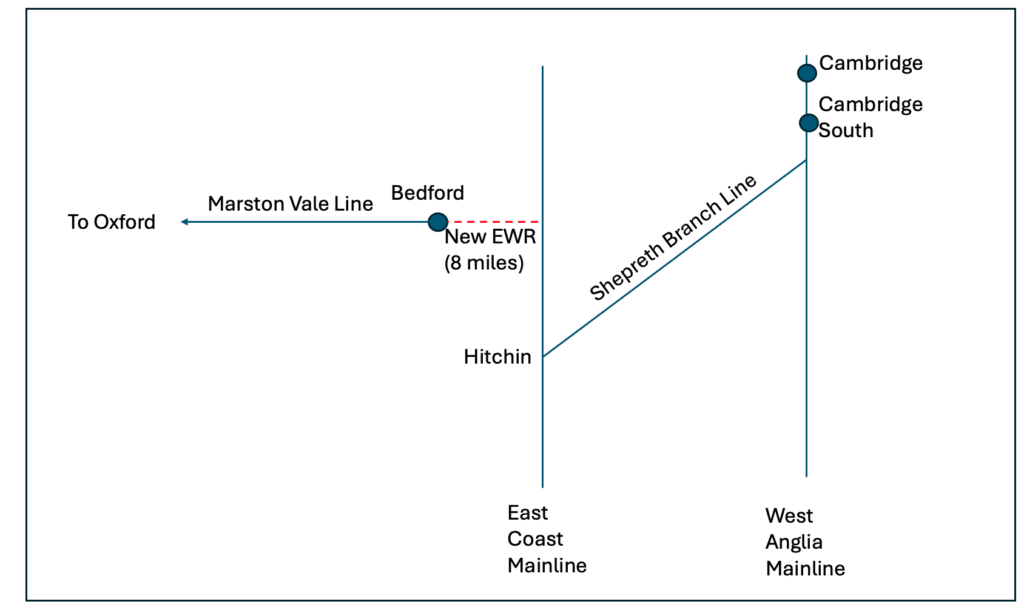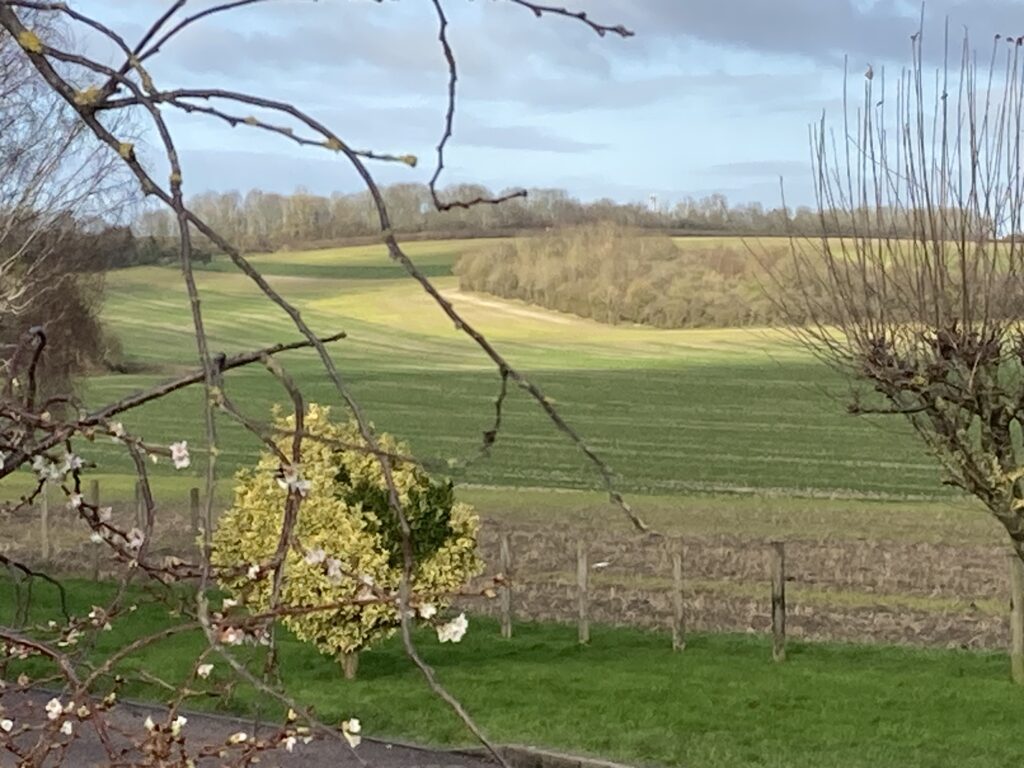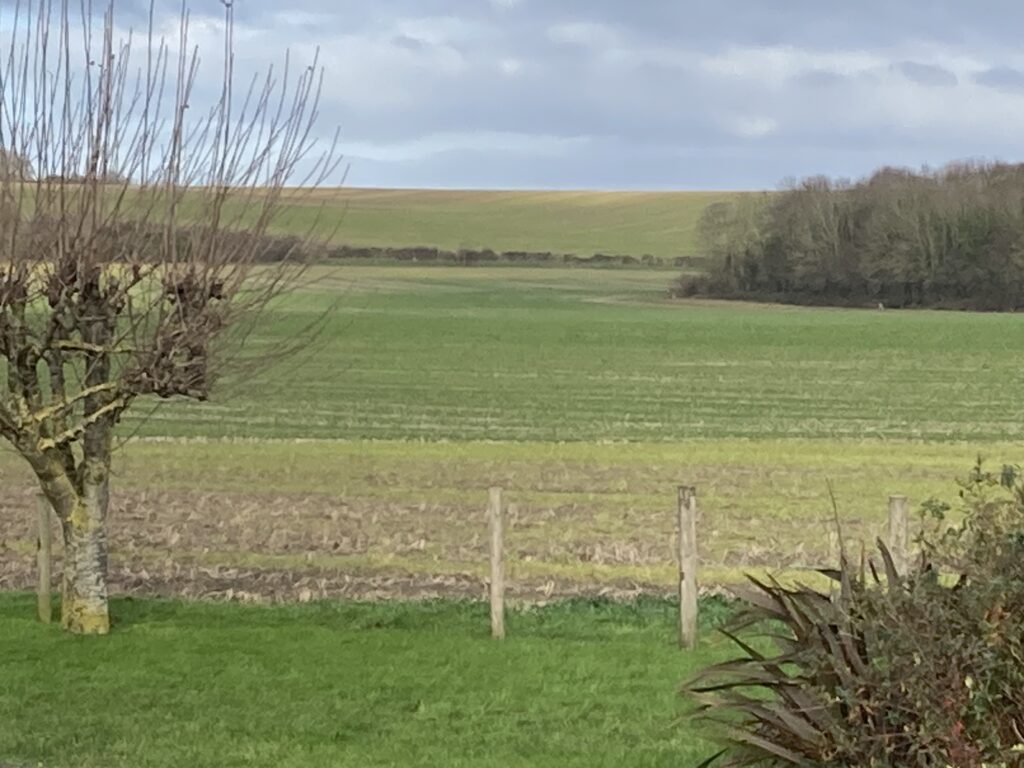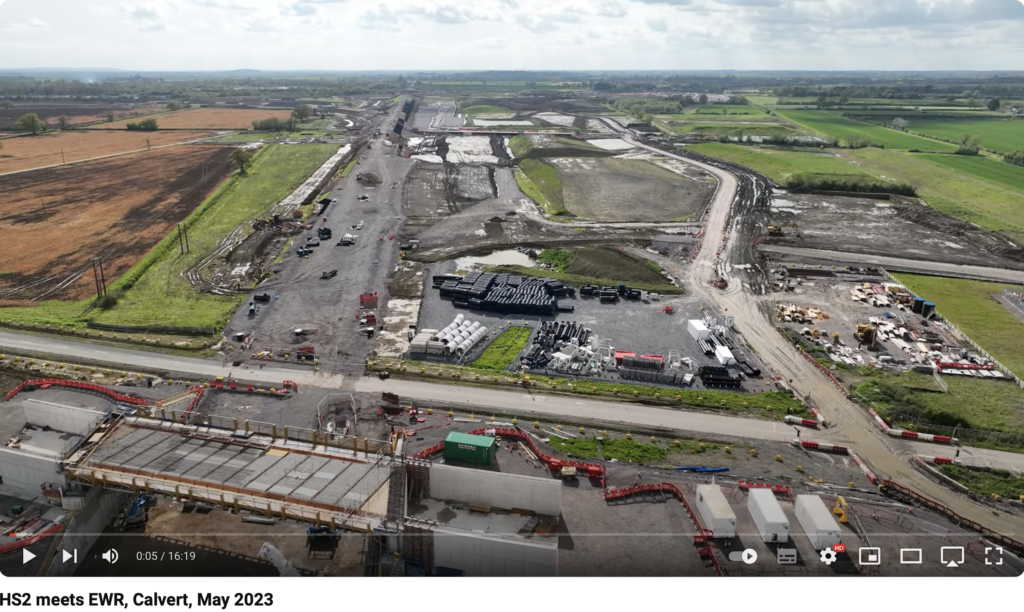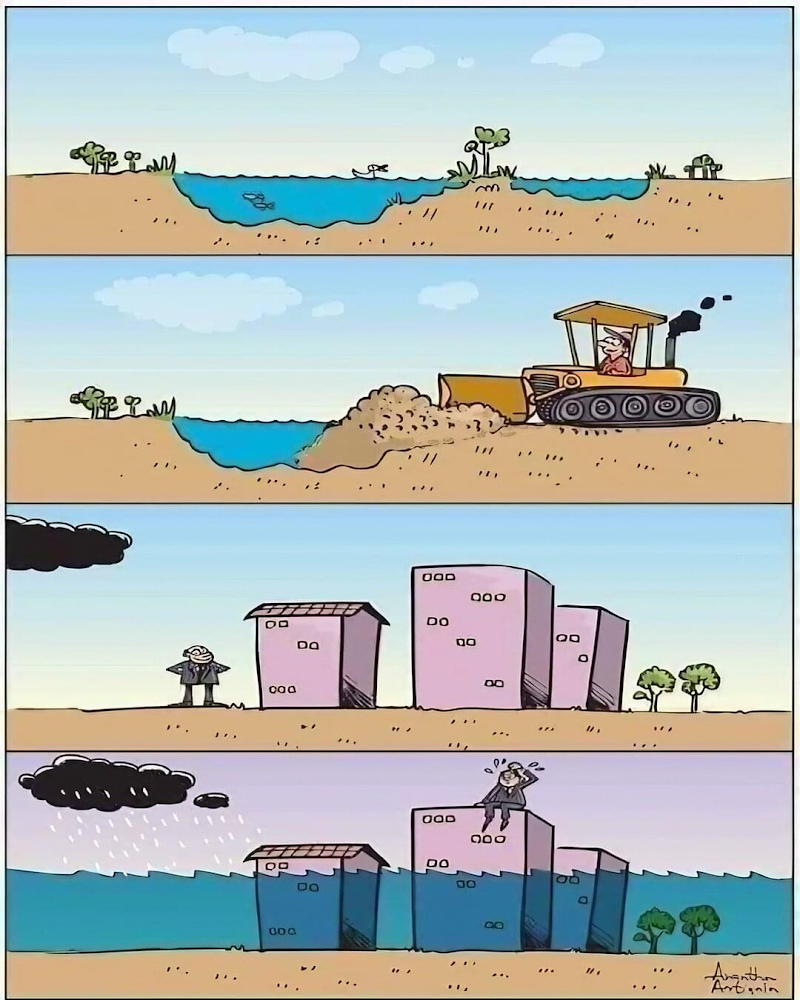(Editor: Here is another news update from CA’s own Graham Turnbull.)
The East West Rail Fiasco
When the i Paper compares East West Rail (EWR) with HS2 with its woeful saga of mismanagement, and asks ‘What’s It For’ it’s safe to assume it is a national question, and not a NIMBY issue limited to villages south of Cambridge threated by the tunnels and the embankments of a new railway. The i headline was New bat tunnel controversy and millions on unused trains: The East West Rail fiasco; in summary, a story of wasted money and poor design.
The 1906 Fishguard rail line was the last time two passenger destinations were linked by a significant new stretch of the UK rail passenger network. (Forty years ago the East Coast Main Line 22km Selby diversion simply enabled a new coal mine.) Now EWR proposes an expensive 50km new line between Bedford and Cambridge (Connection Stage 3) which makes it a once-in-a-century scheme. (David Hughes, CEO at EWR Co. modestly said once in a generation.)
While EWR is unusual it is not a unique scheme in technical terms, and lessons that could have been learned from HS2 and elsewhere have not been learned. The HS2 River Chess chalk stream experience is relevant to our chalk aquifer and obviously bats are roosting on EWR the preferred route. Resurrecting abandoned or underused rail routes is not uncommon and EWR Oxford to Bedford is one recent example. However, EWR Bedford to Cambridge is a different order of magnitude compared to such reuse of existing track beds in terms of cost, challenging terrain and geology. What EWR proposes for the Bedford to Cambridge route is a very expensive venture and it needs to be managed with appropriate care.
Unfortunately, EWR is handling the whole EWR Oxford to Cambridge project in isolation, and with undue haste, rather than appropriate care. This is evident in the £1.3bn Connection Stage 1 (CS1) Bicester London Road level crossing closure and particularly evident in Cambridge where the intended passengers actually need to use all three Cambridge stations, not just two. Any once-in-a-century scheme means building for the future, and in Cambridge that must include serving the city’s northern fringe now undergoing major economic expansion and it certainly does not mean routing heavy freight trains through the heart of Cambridge as EWR currently proposes.
Turn-Backs
The proposed EWR (CS3) route to Cambridge terminates in Cherry Hinton, permanently isolating Cambridge North station and the intended turn-back siding buffers are likely there to stay for many years. What happens at the other end of CS3 at Bedford is where the £8bn cost begin. (Editor: This cost estimate is for CS2 and CS3, see also our recent analysis of turn-back options) The very recently updated EWR plans to drastically remodel Bedford town centre are both unpopular and, as we now discover by its own admission, unnecessary. What happens in Bedford is important to Cambridge because it affects the purpose of EWR and very importantly the route and the funding.
Universal
The big news about EWR is that in its ill-judged haste to push ahead, and dismiss all local concerns along the entire route, the organisation in charge (EWRCo) did not understand that the biggest economic growth prospect along the entire Ox Cam corridor this decade and the next is the wide area around the old Bedford brick works. Actually the economic impact of the Bedford Universal Theme Park tourist attraction probably dwarfs any other single site development on the Ox Cam Arc this side of 2050. Cambridge will continue to grow within the limits of its congested roads, overpriced housing, constraints on water and now sewerage and worn out infrastructure, but Bedford is where the big money will get spent by developers, by tourists and by Government. International visitors using Heathrow or the expanding Luton Airport can arrive by train to an enlarged Thameslink station at Wixams on the east side of the Park and a very short 35 per-hour-shuttlebus journey to the Theme Park with its hotel.
EWR in its haste to show progress published plans in 2024 to rebuild Stewartby Station on the Marston Vale Line and close Kempston Hardwick Station. Unfortunately for EWR, Universal acquired the land in 2023, held public consultations through 2024 and had long decided Kempston Hardwick Station is to be the only public entrance on the west side of the Theme Park. According to Universal’s 2025 planning application ‘Consideration was given to including the new EWR Station within this planning proposal. However, as the station would be delivered by East West Rail it was considered preferable for it to be consented separately.’ (paragraph 3.5.2.) It is now up to EWR to obtain the necessary consents and deliver a new larger Kempston Hardwick Station and an EWR rail passenger service by 2031.(Travel Plan)
If EWRCo can’t meet that opening date Universal intends to run a 14 per-hour-shuttlebus service from Milton Keynes to the Park. That is a lot of additional road miles when Universal want around 40% of visitors to travel by rail, with coaches and taxis accounting for 20% and the remaining 40% by family car. Those shuttlebus numbers point to Kempston Hardwick EWR passengers comprising 28% of rail passengers to the two Theme Park stations, so EWR does need to be ready with that rail passenger service.
EWRCo has ignored what was known across Government Departments for some time. The excuse that in 2024 there was no approved redevelopment for the Bedford brickworks site is incredible. EWR just pushed ahead spending considerable sums of public money devising inappropriate plans for the CS2 Marston Vale Line. This is reminiscent of HS2 with the managing company, EWRCo, lacking clear understanding that the current nationally important objective is opening the Universal Theme Park in 2031 including travel routes. (Editor: EWRCo.’s current message to parish councillors is that Universal would not have invested without the commitment by government to take EWR to Cambridge. We are informed by Bedford Borough Councillors who have met Universal that they never made this a condition for their investment and that EWRCo.s assertion is ‘utter bollocks’. EWRCo. seem to be joining any bandwagon available to justify their project. Their previous excitement about biotech companies seems to have diminished, as Sir John Bell (Professor of Medicine at Oxford University) recently stated on Radio 4’s Today Program this week ‘he’d spoken to several bosses of major companies in the past six months and they are all in the same place, that is, they are not going to do any more investing in the UK’).
Rail Minister Tells Us What it’s for
That brings us back to the question facing the EWR route: ‘What’s It For?’. Lord Hendy, the Rail Minister, in February this year described EWR to Rail Magazine ‘as a quite intensive medium-length passenger service to significantly grow the economy, build houses, and create jobs between Oxford and Cambridge’ and said “nobody designed East West Rail to be a major route for freight”. The Treasury Permanent Secretary at the Public Accounts Committee in June said “Is that a railway project with East West Rail? Is it a housing project with Cambridge, Oxford and a potential new town? Is it a business project that is generating growth, labs and all of that? The answer is that it is all those things”. So what happened to potential commuters to Cambridge from along the line justifying EWR, and what exactly is the purpose of the Bedford to Cambridge section of EWR?
Development Consent Order Process
The EWR scheme was branded ‘transformational’ by Government and has a protected life amid repeated claims that a cost-benefit analysis simply is not possible for schemes that change people’s lives or give a boost to the national economy. (Editor: EWRCo. estimated the Benefit to Cost Ratio for EWR CS2 and CS3 at 0.3 in May 2023) Eventually however, EWR will submit an application for a Development Consent Order (DCO) and that brings scrutiny, rules about due process and the required supporting evidence. For Nationally Significant Infrastructure Projects such as EWR the Planning Inspectorate consideration is comprehensive, including how the project aligns with national policy and planning guidance, including principles of climate, people, places, and value. The Inspectorate assesses the proposal’s impacts and benefits, ensuring the applicant has followed the consultation process, and evaluate the adequacy of their proposed mitigation measures. [Notice the words value and benefits.] The Inspectorate makes recommendations within the strict framework of National Policy Statements (NPSs) and Section 105 of the Planning Act 2008 sets out what the Secretary of State must have regard to in making his or her decision.
The Inspectorate ultimately provides a recommendation on the development consent to the relevant Secretary of State. That recommendation is the carefully considered rational judgement, but the Secretary for State can make a contrary ruling as happened for the Luton Airport expansion. However the Minister’s discretionary powers are limited for a railway by the 2024 National Networks NPS ‘that sets out the need for, and government’s policies to deliver, development of Nationally Significant Infrastructure Projects (NSIPs) on the national road and rail networks in England.’ Significantly, applications ‘will normally be supported by a business case.’ (Editor: We are told by EWRCo. that EWR will be the first NSIP to follow the new planning rules currently going through parliament in the Planning and Infrastructure Bill and for example the statutory consultation expected to start in March/April 2026 will be in phases).
If the Minister approved EWR Bedford to Cambridge without solid evidence in a business case it would be a very brave decision. (Editor: Note that the Department for Transport is on record saying that publication of even the concept level Strategic Outline Business Case is not in the public interest. How can £2.5billion of public money be allocated to this project when they are still working on the rationale for it?).
EWR has now started the DCO process by submitting a formal pre-application scoping document to the Inspectorate that includes ‘Building brand new railway infrastructure between Bedford and Cambridge’. Barrington Parish Council made a submission to the Planning Inspectorate stating ‘that the Scoping Report is inadequate‘.
How can EWR create a DCO application for the EWR railway scheme that is justified by dependant new housing and employment (or alternatively predicted passenger numbers) when, as yet, those benefits and the business case cannot be stated in even the broadest terms? And broad terms won’t meet the DCO criteria below.
NPS Requirements
Applications for rail projects such as EWR are governed by the National Networks National Policy Statement (NPS) which states
- ‘National road or rail schemes that have been identified in relevant Road or Rail Investment Strategies will have been subject to an options appraisal process ……… and proportionate consideration of alternatives will have been undertaken as part of the investment decision making process. ………… The Examining Authority and the Secretary of State should satisfy themselves that the options appraisal process has been undertaken'( §4.21)
- applications ‘will normally be supported by a business case’ (§4.6 )
- ‘The purpose of the economic dimension of the business case is to identify the proposal that delivers best public value to society, including wider social and environmental benefit’ (§4.6)
- ‘The information provided on the economic, environmental and social impacts of a development that underpins the business case will be proportionate to the development’ (§4.7)
- ‘An assessment of the benefits and costs of schemes under a range of scenarios should reflect future uncertainty, in addition to the core case. The modelling should be proportionate to the scale of the scheme and include appropriate sensitivity analysis to consider the effects of uncertainty on project impacts'(§4.9)
That the EWR options appraisal process (§4.21 above) was not evidence-based and was curtailed at each stage of the schemes development with insufficient analysis of practicability, inherent cost differences and degree of benefit has been a source of repeated criticism. Consultants for EWR identified an approach route to Cambridge that avoided challenging terrain and cost less, yet was disregarded in favour of the current proposal. The reason given by EWR was down to ‘the benefits predicted through the Theory of Change by serving the Cambridge Biomedical Campus‘. The supporting EWR Logic Map for a proper Theory of Change analysis which states specific objectives and measurable outcomes, if it exists, has not been made public unlike the nearby A428 Black Cat road scheme. The proposed route into Cambridge has not been justified and is transformational for the wrong reasons. (Editor: It’s not just us that feel this way: Vectos, transport consultants to Universal Studios recently reviewed EWRCo.s November 2024 consultation and concluded: ‘This note has set out our substantive concerns from a technical aspect on EWR Co’s non-statutory consultation. Whilst we recognise that this is an early stage of consultation, because of the absence of technical detail or evidence to substantiate the information provided, together with a lack of explanation of alternative options considered, it is considered impossible to provide complete comments at this stage.‘)
The first rule of mitigation, as the University of Cambridge explained to EWR this year, is do not encroach on a protected zone and EWR has twice ignored that principle, once in the case of the rare bat species (as did HS2) and again by routing the track through the protection zone of the Mullard Radio Astronomy Observatory (MRAO).
The above NPS rules together provide a yardstick to measure the once-in-a-century scheme EWR proposes: business case, best value, social and environmental benefit. It probably is cost effective for EWR to upgrade the Marston Vale Line to Kempston Hardwick and a turn-back facility at the existing Bedford sidings site as EWR proposed and that upgrade could be a stand-alone application by EWR to the Planning Inspectorate. There is a business case (passengers to the Theme Park), and it offers high value and has social benefit. In fact the Marston Vale part of EWR should be a separate DCO, it is rejuvenation of existing track at a trivial cost compared with the £8bn for Bedford to Cambridge CS3. Combining the two into one DCO puts a minnow as equal in size to a whale.
However, if at any time EWR adds in the cost of its planned rebuilding of the two Bedford city centre railway stations and demolishing 47 properties there is a substantial problem. EWR described its plans for an enlarged Bedford Station as ‘ambitious and transformative‘ but to residents the plans are highly controversial.
Ashburnham Road Destroyed to Save Time.
In August, Bedford Borough Council vowed to fight the EWR’s newly announced plans to demolish multiple flats, a GP surgery and long-established local businesses at 2-20 Ashburnham Road close to Bedford station. This adds 10 more properties to the 37 already on the EWR demolition list in Bedford’s Poets Corner to provide space for additional rail tracks for EWR trains north of Bedford station.
A recent information request to EWR revealed ‘Our updated plans now include additional land for the construction compound, which would allow for the safer and more efficient construction of the upgrades to Bedford station, reducing our construction programme significantly.’ If EWR cannot demolish these homes it could extend the project by a further two to three years according to Councillor Nicola Gribble. EWR could, if it wished, avoid demolishing so many properties if it kept the construction compound to the original planned size needed to redeveloped Bedford station. Demolishing homes and businesses to hasten that station redevelopment is unnecessary, since the additional facilities required for the EWR service to Cambridge cannot be used by passengers before mid-2030’s according to EWR.
Again this is evidence that EWR devised detailed plans for the Marston Vale Line in isolation without effective consultation with the community and the Borough Council and curtailed the evaluation of alternative routes. Recently the Planning Inspectorate has advised Bedford Borough Council to withdraw its current Local Plan and work on a new plan incorporating the Theme Park and all its implications. The impact of the Theme Park on Bedford and the local economy is huge and the Borough Council needs additional skilled manpower, and time, to rework the Local Plan and ensure the local infrastructure can supply the additional electricity, sewerage and water for about 23,000 daily visitors. EWR wants to steam-roller its preferred plan through and dictate the shape of the entire town centre by re-routing roads, demolishing houses and businesses, rebuilding the two Bedford stations and putting a multistorey car park on hospital land. The nature of Bedford town centre should be the responsibility of the Borough Council and its Mayor not EWRCo, and its owner DfT, according to Government devolution plans.
Remodelling the centre of Bedford as EWR propose is contentious in Bedford for the same reason the proposed EWR route into Cambridge is contentious – the benefits to the inhabitants aren’t worth the disruption and losses to the two communities, it’s the wrong route and the £8bn cost is not justified by the passenger traffic predicted by EWR. The DCO process will expose these deficiencies in the EWR plans.
Conclusion
EWR promise a DCO application after a Statutory Consultation, probably some time in 2026. The detailed consultation documents will be widely examined by local authorities and the public and challenged in order to place on record errors and omissions that will, in turn, be notified to the Planning Inspectorate when EWR makes its DCO application. The EWR scheme changes at the DCO stage from being politician driven (Ministers and Treasury mandarins) to an independent legally defined assessment (the Planning Inspectorate). For such a significant, and expensive, once-in-a-century scheme as the Bedford to Cambridge rail route the scrutiny will be proportionate and rigorous and will be seen to be so in the Inspectors published report.
